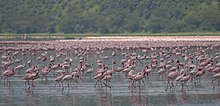Lake Nakuru National Park
|
Lake Nakuru National Park
|
||
|
View from the Baboon Cliffs |
||
| location |
Nakuru County , Kenya |
|
| surface | 188 km² | |
| WDPA ID | 762 | |
| Geographical location | 0 ° 22 ′ S , 36 ° 5 ′ E | |
|
|
||
| Setup date | 1967 | |
| administration | Kenya Wildlife Service | |
The Lake Nakuru National Park is located in Nakuru around Lake Nakuru in Kenya , about 160 km north-west of the capital Nairobi . It is visited by around 200,000 visitors and tourists annually, making it the second largest number of visitors behind the Masai Mara .

The unique natural spectacle of around two million flamingos made it necessary to protect the animals early on. In a first step, the colonial government declared the southern two thirds of today's park a bird sanctuary in 1961. In 1967 the park became the first bird protection national park in all of Africa under the new Black African government. In 1969 the park was extended to the whole lake and the surrounding area and has since grown to 188 km². 450 species of birds, including 90 water birds, have been recorded. Over 50 species of mammals (antelope, waterbuck, monkey, buffalo, giraffe ) and snakes are registered here, and you can even see lions. The park has no elephants, it is too small for that. The largest pure tree euphorbia ( Euphorbia candelabrum ) in Africa grows on the eastern shore of the lake . The baboon cliffs (baboon cliffs) on the southwestern edge offer the visitor a magnificent overview of the entire lake and the scenery of the flamingo colonies. These Baboon Cliffs are one of the few places where you can and may safely get out of the car. Baboons , or English baboons , usually stay here . If you approach the lake, you can smell and hear the birds with their loud clatter. You can also see the flamingo nests with their eggs or chicks very well during the breeding season.
The national park is also a rhino sanctuary with a population of more than 60 black and white rhinos that have been brought here from all parts of Kenya and are protected by 14 rangers (game rangers) around the clock. The two rhino species you can already distinguish from a distance easily: black rhinos ( black rhino ) hold their heads high and pluck with their pursed lips leaves of bushes and small trees. White Rhino ( White rhino ) eating with his head down and their mouths wide exclusively grass. "White" has nothing to do with color, but is an English reinterpretation of "wide" = far or wide.
In 1977 some of the very rare and endangered Rothschild giraffes were brought here, which have multiplied so strongly to 70 specimens that they could be released back into the wild as far as Uganda, where they were threatened with extinction due to the civil war.
Web links
- Kenya Wildlife Service: Lake Nakuru National Park (English)


